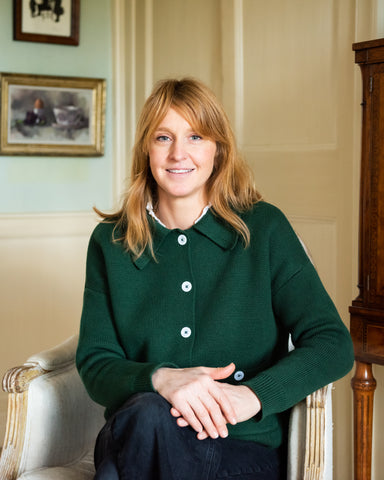
Having been neck-deep in the interior world for much of my professional life, I have built wonderful relationships with fellow vintage and textile enthusiasts, plus gained some incredible friendships along the way. It was my absolute pleasure to catch up with the wonderfully eclectic Octavia Dickinson and pick her brains on all things interiors. We endlessly discussed disrupting room designs with fun pieces that work inexplicably, and about making unique statements that represent yourself, your home and how you live in it.
Octavia’s interiors are joyful, layered and decorative. Drawing on her art-history training at the Courtauld Institute in London, she approaches a room like a beautiful painting, combining colours and shapes in compositions which delight the senses – but never jar.
Octavia enjoys offsetting textures and finishes, using fabric to soften hard edges, adding trims and ample lamplight, plus mixing furniture styles for a homely and eclectic feel. She aims to conjure a feast for your eyes, that you will never tire of and achieves this with great success! Octavia’s approach to interiors is underpinned by her deep understanding of what makes a home comfortable through colour, texture and antiques, which conjures a bold yet timeless English country house style. Read her insight from our recent catch-up below.
How do you go about incorporating them into your work?
I love using antique textiles in a scheme as I constantly try to make rooms feel lived in, like they have been there a long time. There are so many ways to use antique textiles; it is more about finding the wonderful seamster to make your ideas a reality. Currently, I am converting an antique quilt into a headboard and also adding a linen border as the quilt is a little narrow. Lovely old silks make the perfect unique lampshade. Tapestries can be hung or made into cushions. Quilts and blankets can be used for their original purpose or as upholstery fabrics – there is nothing lovelier than the squishy, sinking-in feeling that they give.
How best to display them?
If using an antique textile as an artwork, I like to treat them like any other form of art and work out what sort of framing or displaying method will enhance the object the most. Textiles are wonderfully tactile so I prefer not to place them behind glass, instead I hang them on metal picture rails or curtain poles. They want to be treated with respect but also used – there is nothing worse than that feeling of everything being too precious.
Where to start when using vintage textiles? Can they inspire a whole scheme?
Yes, vintage textiles can inspire a whole scheme, as well as disrupting an already-made scheme to make it even more perfect. The best rooms are ones that have a timelessness to them, where, even if it has all been designed and placed the day before, it looks like the objects and fabrics in the room have slowly come together, bickering harmoniously. If you have a textile that you want to use, let it be the starting place, but also, if you come across one down the line, it can be the perfect addition to an already established room.
Unique creative ways of working with vintage textiles?
There are endless ways to utilise vintage textiles, but I would look at the size of the textile to establish what it could be used for. There is no point in putting a gigantic Suzani on the top of a tiny footstool as it is a waste unless you use the rest of the textile to make other things like scatter cushions or squab cushions for chairs. Depending on the standard of the cloth, don’t be afraid to manipulate it – you can use the patterns on a Suzani to embellish curtain fabric or a headboard. If a vintage textile is not thick enough, you can back them to make them stronger to use them for upholstery. Sew different textiles together to make striped curtains, and patchwork them together if you have numerous small pieces. Thin silks and linens make wonderful lampshades.
Why do you love working with vintage textiles?
Vintage textiles are the perfect antidote to a designed room – they infuse it with life and offset the newness to create a much more lived-in feel. They also can make a room feel a lot more unique. But I mostly love working with antique textiles for the joy of their patterns and beautiful aesthetics and thinking about the wonderful artistic talent of the past and future.
Why would you recommend others to work with vintage textiles?
They give a sense of timelessness and using vintage textiles is a wonderful way to recycle. There is nothing more satisfying having something you know no one else will have. Something that’s off the beaten track and there is most likely only one of it. These small details make a house unique to the people who live it in, and that’s what I strive to do.
What would your top 3 tips be for anyone looking to start using vintage textiles?
Buy what you love.
Buy from trusted dealers with the same taste as you.
Do ask about the condition and ask for lots of detailed photos.
How has the fabric and textile industry evolved since you became a part of it and what do you see and hope for the future of it?
From my eyes it seems to have expanded a lot with many more dealers emerging, and a lot more artisan craftsmen working with antique textiles in various ways. I also think that there is a move towards a desire to reuse and recycle for ecological reasons and to bestow a uniqueness to one’s own home. I hope that the fabric and textile industry carry on expanding and becomes an easy place to navigate for new clients. With an openness and transparency that I look for in all trades that I work with.




